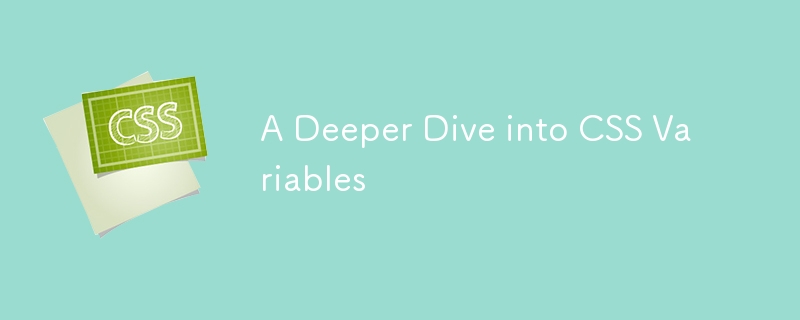A Deeper Dive into CSS Variables

I recently embarked on a personal project to build a digital clock using JavaScript. As a way to challenge myself and expand my knowledge, I decided to add a theming feature to the project. This is where I stumbled upon CSS variables, a powerful tool for managing styles in a dynamic way.
TLDR
Learned about CSS variables and their benefits for creating dynamic themes in web projects. Centralized style definitions, easy theme switching, and improved readability are key advantages. Also explored the prefers-color-scheme media query for automatic theme adjustments.
Try it yourself/Code example
Initially, I was a bit overwhelmed by the concept of CSS variables. However, as I delved deeper, I realized their immense potential. By defining variables within the :root pseudo-class, I could centralize color definitions and easily update the entire theme throughout my project. This not only made my code more maintainable but also gave me greater flexibility in customizing the clock's appearance.
Key Takeaways:
Centralized Style Definitions: Placing CSS variables within the :root pseudo-class creates a single point of reference for all theme-related styles. This makes it easier to manage and update the overall appearance of your project.
Dynamic Theme Switching: By using var() functions throughout your CSS, you can dynamically update styles based on the current value of the CSS variables. This allows you to create multiple themes and switch between them with minimal code changes.
Improved Readability: Using CSS variables can make your code more readable by separating color definitions from the actual styles. This can be especially helpful for larger projects with complex styling requirements.
Expanding the Scope:
While I didn't include it in this specific project, I also learned about the prefers-color-scheme media query. This query allows you to automatically adjust the theme based on the user's system preference, providing a more personalized experience.
Future Applications:
I'm excited to apply my newfound knowledge of CSS variables to future projects. I can see their potential in creating dynamic and visually appealing websites, especially for projects that require multiple themes or frequent style updates.
Conclusion:
This personal project was a valuable learning experience. I not only gained a deeper understanding of CSS variables but also discovered how they can be used to create dynamic and visually appealing web applications. As I continue to explore the world of web development, I'm excited to see how I can leverage CSS variables to enhance user experience and elevate my design skills.
Try it yourself:
Click the '?'(help) on the top-right of the page. I will talk about the newly introduced popover element in the HTML. popover API
The above is the detailed content of A Deeper Dive into CSS Variables. For more information, please follow other related articles on the PHP Chinese website!

Hot AI Tools

Undresser.AI Undress
AI-powered app for creating realistic nude photos

AI Clothes Remover
Online AI tool for removing clothes from photos.

Undress AI Tool
Undress images for free

Clothoff.io
AI clothes remover

Video Face Swap
Swap faces in any video effortlessly with our completely free AI face swap tool!

Hot Article

Hot Tools

Notepad++7.3.1
Easy-to-use and free code editor

SublimeText3 Chinese version
Chinese version, very easy to use

Zend Studio 13.0.1
Powerful PHP integrated development environment

Dreamweaver CS6
Visual web development tools

SublimeText3 Mac version
God-level code editing software (SublimeText3)

Hot Topics
 1664
1664
 14
14
 1423
1423
 52
52
 1317
1317
 25
25
 1268
1268
 29
29
 1246
1246
 24
24
 How to Create an Animated Countdown Timer With HTML, CSS and JavaScript
Apr 11, 2025 am 11:29 AM
How to Create an Animated Countdown Timer With HTML, CSS and JavaScript
Apr 11, 2025 am 11:29 AM
Have you ever needed a countdown timer on a project? For something like that, it might be natural to reach for a plugin, but it’s actually a lot more
 HTML Data Attributes Guide
Apr 11, 2025 am 11:50 AM
HTML Data Attributes Guide
Apr 11, 2025 am 11:50 AM
Everything you ever wanted to know about data attributes in HTML, CSS, and JavaScript.
 A Proof of Concept for Making Sass Faster
Apr 16, 2025 am 10:38 AM
A Proof of Concept for Making Sass Faster
Apr 16, 2025 am 10:38 AM
At the start of a new project, Sass compilation happens in the blink of an eye. This feels great, especially when it’s paired with Browsersync, which reloads
 While You Weren't Looking, CSS Gradients Got Better
Apr 11, 2025 am 09:16 AM
While You Weren't Looking, CSS Gradients Got Better
Apr 11, 2025 am 09:16 AM
One thing that caught my eye on the list of features for Lea Verou's conic-gradient() polyfill was the last item:
 A Comparison of Static Form Providers
Apr 16, 2025 am 11:20 AM
A Comparison of Static Form Providers
Apr 16, 2025 am 11:20 AM
Let’s attempt to coin a term here: "Static Form Provider." You bring your HTML
 How to Build Vue Components in a WordPress Theme
Apr 11, 2025 am 11:03 AM
How to Build Vue Components in a WordPress Theme
Apr 11, 2025 am 11:03 AM
The inline-template directive allows us to build rich Vue components as a progressive enhancement over existing WordPress markup.
 PHP is A-OK for Templating
Apr 11, 2025 am 11:04 AM
PHP is A-OK for Templating
Apr 11, 2025 am 11:04 AM
PHP templating often gets a bad rap for facilitating subpar code — but that doesn't have to be the case. Let’s look at how PHP projects can enforce a basic
 The Three Types of Code
Apr 11, 2025 pm 12:02 PM
The Three Types of Code
Apr 11, 2025 pm 12:02 PM
Every time I start a new project, I organize the code I’m looking at into three types, or categories if you like. And I think these types can be applied to




